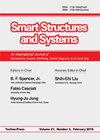基于高效AI机制的基准结构SHM特征优化选择
IF 2.2
3区 工程技术
Q2 ENGINEERING, CIVIL
引用次数: 2
摘要
结构健康监测(SHM)作为民用基础设施状态评估和性能评价的多学科技术解决方案,正在迅速发展。它包括三个部分:数据收集、数据处理(特征提取/选择)和决策(特征分类)。为了有效地对SHM数据进行降维,本研究提出了先进的特征提取、基于优化算法的特征子集选择、基于人工智能方法的有效代理模型等方法。这些框架增强了SHM过程应对不确定性和大数据问题的能力。为了实现这一目标,本文提出了一个基于三个主要块的框架:基于小波口袋相对能量(WPRE)的特征提取块、基于改进的二元和谐搜索算法的特征选择块和基于小波加权最小二乘支持向量机(WWLS-SVM)的特征分类块。针对每个块,将所提出的框架的性能与各种已知方法进行了比较。结果将使用精度、召回率、准确性和特征减少的度量来呈现。此外,为了证明所提方法的鲁棒性,研究了六个SHM领域的知名基准数据集。结果验证了所提方法在提供数据减少和加速损伤检测过程方面的适用性。本文章由计算机程序翻译,如有差异,请以英文原文为准。
Optimum feature selection for SHM of benchmark structures using efficient AI mechanism
Structural Health Monitoring (SHM) is rapidly developing as a multi-disciplinary technology solution for condition assessment and performance evaluation of civil infrastructures. It consists of three parts: data collection, data processing (feature extraction/selection), and decision-making (feature classification). In this research, for effectively reducing a dimension of SHM data, various methods are proposed such as advanced feature extraction, feature subset selection using optimization algorithm, and effective surrogate model based on artificial intelligence methods. These frameworks enhance the capability of the SHM process to tackle with uncertainties and big data problem. To reach such goals, a framework based on three main blocks are proposed here: feature extraction block using wavelet pocket relative energy (WPRE), feature selection block using improved version of binary harmony search algorithm and finally feature classification block using wavelet weighted least square support vector machine (WWLS-SVM). The capability of the proposed framework is compared with various well known methods for each block. Results will be presented using metrics of precision, recall, accuracy and feature-reduction. Furthermore, to show the robustness of the proposed methods, six well-known benchmark datasets of SHM domain are studied. The results validate the suitability of the proposed methods in providing data reduction and accelerating damage detection process.
求助全文
通过发布文献求助,成功后即可免费获取论文全文。
去求助
来源期刊

Smart Structures and Systems
工程技术-工程:机械
CiteScore
6.50
自引率
8.60%
发文量
0
审稿时长
9 months
期刊介绍:
An International Journal of Mechatronics, Sensors, Monitoring, Control, Diagnosis, and Management airns at providing a major publication channel for researchers in the general area of smart structures and systems. Typical subjects considered by the journal include:
Sensors/Actuators(Materials/devices/ informatics/networking)
Structural Health Monitoring and Control
Diagnosis/Prognosis
Life Cycle Engineering(planning/design/ maintenance/renewal)
and related areas.
 求助内容:
求助内容: 应助结果提醒方式:
应助结果提醒方式:


